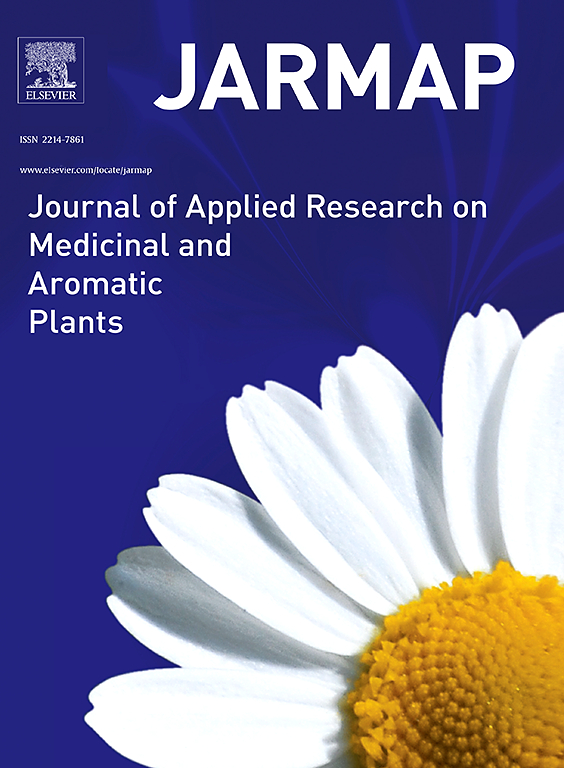Mechanical intra-row weed control at early growth stages in medicinal and aromatic plants using the example of parsley (Petroselinum crispum (Mill.) Fuss) and lemon balm (Melissa officinalis L.)
IF 3.6
2区 农林科学
Q1 PLANT SCIENCES
Journal of Applied Research on Medicinal and Aromatic Plants
Pub Date : 2025-01-16
DOI:10.1016/j.jarmap.2025.100623
引用次数: 0
Abstract
Weed control in medicinal and aromatic plants (MAP) is particularly challenging as many species have a low competitiveness at early growth stages. Intra-row (within the row) mechanical weed control is most challenging since crops may be damaged as well. Here we compared five different devices for mechanical intra-row weeding (finger, torsion and rotative weeders, tine harrow, ridger share) in lemon balm and parsley, focusing on the critical stage of crop establishment. In total, eight field trials were carried out in 2020 and 2021 at two experimental farms of the University Bonn in the west of Germany. The devices were tested in replicated trials after optimising the settings on test plots. Data on weed control efficacy (WCE) and crop damage were analysed with ANOVA. The average WCE was 66 % and had a high variability ranging from 0 % to 100 %. Tine harrows could be applied most often and at earlier growth stages, followed by finger weeder. Highest crop damage was noted after use of rotative weeder. Yield decreasing effects were only significant in two cases and tended to be lower in transplanted than in sown lemon balm and parsley. However, due to variable operating conditions a consistent ranking of weeding devices was not possible. We conclude that despite significant technical progress during the last two decades, a complete replacement of herbicides is difficult at present, unless weed control is carried out manually. Further research is needed to ascertain under which environmental and management conditions mechanical intra-row weeding is most effective in the field, and how these techniques can be best integrated with other weed control methods.
药用和芳香植物生长早期行内杂草的机械控制——以欧芹(Petroselinum crispum)为例柠檬香蜂草(Melissa officinalis L.)
药用和芳香植物(MAP)的杂草控制尤其具有挑战性,因为许多物种在生长早期的竞争力较低。行内(行内)机械杂草控制是最具挑战性的,因为作物也可能受到损害。在这里,我们比较了柠檬香蜂草和欧芹中五种不同的机械行内除草装置(手指除草器、扭转和旋转除草器、定时耙除草器、犁铧除草器),重点关注作物建立的关键阶段。总共在2020年和2021年在德国西部波恩大学的两个实验农场进行了8次田间试验。在对试验田的设置进行优化后,对这些设备进行了重复试验。采用方差分析对杂草防治效果和作物危害数据进行分析。平均WCE为66 %,并具有从0 %到100 %的高变异性。在较早的生长阶段,最常使用时耙,其次是手指除草机。轮作除草机对作物的危害最大。只有两种情况的减产效果显著,移栽时的减产效果往往低于播种时的减产效果。然而,由于操作条件的变化,除草装置的一致排序是不可能的。我们的结论是,尽管在过去二十年中取得了重大的技术进步,但目前很难完全替代除草剂,除非进行人工杂草控制。需要进一步研究确定在何种环境和管理条件下行内机械除草在田间最有效,以及如何将这些技术与其他杂草控制方法最好地结合起来。
本文章由计算机程序翻译,如有差异,请以英文原文为准。
求助全文
约1分钟内获得全文
求助全文
来源期刊

Journal of Applied Research on Medicinal and Aromatic Plants
Pharmacology, Toxicology and Pharmaceutics-Drug Discovery
CiteScore
6.40
自引率
7.70%
发文量
80
审稿时长
41 days
期刊介绍:
JARMAP is a peer reviewed and multidisciplinary communication platform, covering all aspects of the raw material supply chain of medicinal and aromatic plants. JARMAP aims to improve production of tailor made commodities by addressing the various requirements of manufacturers of herbal medicines, herbal teas, seasoning herbs, food and feed supplements and cosmetics. JARMAP covers research on genetic resources, breeding, wild-collection, domestication, propagation, cultivation, phytopathology and plant protection, mechanization, conservation, processing, quality assurance, analytics and economics. JARMAP publishes reviews, original research articles and short communications related to research.
 求助内容:
求助内容: 应助结果提醒方式:
应助结果提醒方式:


